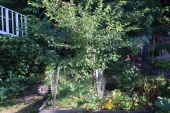Eric Thompson wrote:
If it's already done, you can save the tree with a "bridge graft" which takes one or more strip of bark and grafts over the girdling. This can be done in Winter or very early Spring. Google "bridge graft" to see some images and basic steps.
I've attempted this myself, but all the grafts failed and the trees died anyway. My damage was not from a weedeater, but mice. I first cut out the damaged sections to make a straight cut margin parallel to the ground. I then tried to "bridge" the gap with bark taken from branches of the same tree. This contrasts completely with my very successful whip grafts when cloning named varieties.
In my personal experience, I'd say if they are still just young trees, just dig them up, throw them out, and start over. In my own orchard, trying to revive injured trees just means you have a patheticlly weak tree limping along much more slowly than anything surrounding it.






